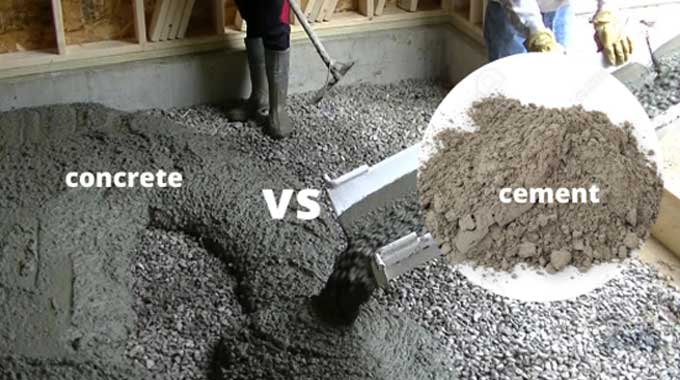
Concrete vs. Cement: The Differences in 2 Materials in Construction Site

It's important to realize that cement and concrete are not the same things. Cement is a component of concrete along with aggregates and paste. A variety of aggregate materials, such as sand, gravel, or crushed stone, are used in the aggregates, while cement and water make up the paste.
People often confuse cement with concrete. Concrete is actually what person usually mean when they use the word cement. Concrete and cement are alternate terms for each other. However, cement and concrete are two completely different materials. A common example can help us understand this. Therefore, one should understand the basic differences between cement and concrete to avoid misunderstanding.
Manufacturing Process
Cement
Raw materials are ground, then burned in a kiln around 1400 degrees Fahrenheit to make cement, which produces cement clinker. Moreover, Gypsum is then added to the cooled clinker after it is ground to a fine powder. Dry or wet processes use in this step.
The cement content in concrete varies from mix to mix, depending on the type of concrete. Hydraulic cement hardens and sets when water adds through a process called hydration, binds the aggregates together, forming a rock-like mixture known as concrete.
Concrete
Concrete manufacturing, therefore, refers to the process of producing fresh concrete and placing it into various forms so that it can harden into building materials. Adding gypsum to the concrete mixture can affect the amount of time it takes to harden. The addition of accelerating admixtures or retarding admixtures can also speed up or slow down this process. Crystals harden in concrete when it sets. Additive materials can accelerate or retard the growth of these crystals.
Adding an air-entraining admixture to concrete in cold-climate areas is a good idea. The admixture in this concrete helps protect the concrete from freezing and thawing by entraining millions of microscopic bubbles. Over time, the process of hardening makes concrete stronger. It is possible to harden concrete underwater and keep it strong even when wet.
Types of Cement and Concrete
Cement
In parallel with the development of manufacturing technology, the types and quality of cement have also evolved. Especially for special projects, the type of cement used must be different. A variety of cement is available with different physical and chemical properties to suit various construction projects.
- Ordinary Portland Cement
- Portland Pozzolana Cement
- Rapid Hardening Cement
- Extra Rapid Hardening Cement
- Quick Setting Cement
- Low Heat Cement
- Portland Slag Cement
- High-Alumina Cement
- White Cement
- Colored Cement
- Air Entraining Cement
- Hydrophobic Cement
- Masonry Cement
- Expansive Cement
- Oil Well Cement
Concrete
Concrete has a wide range of applications. Thus, concrete types become necessary to meet the demands for various challenges.
Ready-mix concrete is one example. This concrete is ready for use on-site, as suggested by its name. As such, it is an excellent alternative to eliminate the limitations of ordinary mixtures because it reduces the amount of work on the construction site and avoids any confusion. In addition to helping overcome limitations regarding quality, it is also helpful when dealing with unskilled labor.
- Ordinary Concrete
- Ready Mix Concrete
- Reinforced Concrete
- Precast Concrete
- Lightweight Concrete
- Polymer Concrete
- Pervious Concrete
- Ferro Cement Concrete
- Plum Concrete
- Transparent Concrete
- Fiber Reinforced Concrete
- Green Concrete
- Self-compacting Concrete
- Bio Concrete
- Fly Ash Concrete
- Pre-stressed Concrete
- High-Density Concrete
- High-Strength Concrete
- Air Entrained Concrete
- Shotcrete Concrete
- Vacuum Concrete
- Pumped Concrete
- Stamped Concrete
- Limecrete
- Roller Compacted Concrete
- Glass Concrete
- Pre-packed Concrete
Uses of Cement and Concrete
Cement
The use of cement alone is never recommended. Known for its binding properties, it uses in the preparation of concrete, mortar, blocks, and other building materials in which it holds together other components. The adhesive property of this material allows holding it together with various construction materials such as tiles, bricks, etc. As a result, Cement can also use as a sealant and a grout.
Concrete
Construction has become increasingly dependent on materials such as concrete. Its unique qualities such as strength, low maintenance, energy efficiency, durability, and sustainability contribute to its popularity. Concrete is an important building material because of its properties.
To learn more, watch the following video tutorial.
Video Source: Today I Found Out
Final Thoughts
To distinguish between concrete and cement, you should use the correct terminology. Otherwise, you won't find one here.
Concrete is a dry mix that becomes semi-liquid during the curing process and hardens into a material similar to stone. Cement is in powder form. Both cement and concrete have distinct properties. Moreover, Concrete is better suited for casting slabs, walls, and columns than cement. Concrete is highly durable, low maintenance, waterproof, long-lasting, and thermally efficient, among other characteristics.


